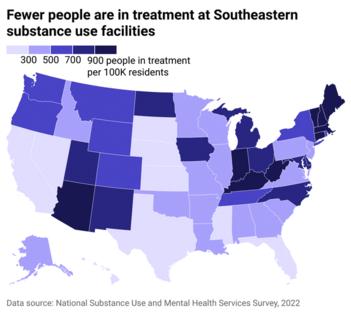States where the most people are receiving substance use treatment
Published in Slideshow World
Subscribe
States where the most people are receiving substance use treatment
Approximately 49 million people in the U.S. population aged 12 or older had a substance use disorder in 2021—and most went without treatment.
That amounted to 17.3% of the population living with these disorders, according to 2022 Substance Abuse and Mental Health Services Administration data released in November 2023. These sometimes deadly disorders are on the rise: The share of Americans with substance use disorders jumped by nearly a percentage point from 2021 to 2022, per SAMHSA data. Reported drug overdose deaths are also rising compared to historical levels, reaching nearly 106,000 in the 12 months ending in September 2023, compared to just under 69,000 during the same period in 2019.
The survey used official diagnostic criteria to determine estimates of the prevalence of substance use disorder, basing questions on the Diagnostic and Statistical Manual of Mental Disorders, 5th edition (DSM-5).
The 2021 SAMHSA survey showed that most who didn't receive treatment believed they didn't need it. But there are many other reasons people don't seek treatment, including a lack of facilities, long waiting lists, and high expenses. There are exceedingly low vacancies at residential substance use rehab facilities, so help isn't always available for those who seek it.
Treatment for substance use disorders can save lives—but treatment options aren't universally accessible. Ophelia identified the number of people in each state being treated at substance use treatment facilities as of the 2022 National Substance Use and Mental Health Services Survey, the most recent and comprehensive data available. For this analysis, statistics are mapped as the number of patients per capita within each state.
Visit thestacker.com for similar lists and stories.
Regional differences in substance use treatment
There is a relatively weak correlation between substance use disorder prevalence and the share of residents in treatment. However, there are some standouts within the data.
For instance, in Washington D.C., SAMHSA estimates that about 23%, or nearly 1 in 4 residents, have substance use disorders—the highest in the nation. However, the district has one of the lowest concentrations of residents in treatment. On the other hand, West Virginia, Maine, and Arizona have high concentrations of people in treatment but relatively average prevalence of the disorders.
Some states reinforce the correlation: Vermont, for example, has the third-highest rate of substance use disorders but also the third-highest rate of people in treatment for those disorders. Texas and Hawaii both have low rates of substance use disorder and low concentrations of people in treatment. SAMHSA provides state profiles to dive deeper into the volume and types of services each state offers.
Since substance use disorder has been more widely viewed as a treatable disease, and in the 13 years since opioid use specifically was declared an epidemic, treatment options and humane care have grown. Still, research has found that there are still high volumes of unmet need nationwide.
The federal government is continually rolling out resources to address this need. In early February 2024, SAMHSA announced two grant opportunities to expand treatment within adult and family treatment drug courts and among pregnant and postpartum people. Last year, the agency awarded tens of millions in grants toward prevention programs, connecting people to treatment and recovery services, and expanding access to medications for opioid use disorder. Some of these have focused on funding state solutions, allowing states to develop services specific to their populations' needs.
Story editing by Ashleigh Graf. Copy editing by Paris Close. Photo selection by Lacy Kerrick.
This story originally appeared on Ophelia and was produced and distributed in partnership with Stacker Studio.








Comments